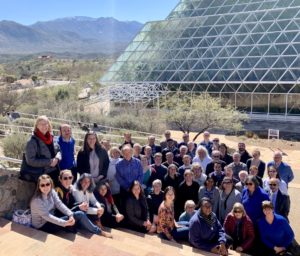Plant Science Research Network releases Decadal Vision 2020-2030
Texas A&M AgriLife contributes two co-authors for the vision
Two Texas A&M AgriLife faculty assisted in the production of the Plant Science Research Network action plan for the plant science community to maximize its impact on pressing global issues such as human health and climate change over the next decade.

David Baltensperger, Ph.D., head of the Department of Soil and Crop Sciences at Texas A&M University, and Seth Murray, Ph.D., Texas A&M AgriLife Research corn breeder and Butler Chair in soil and crop sciences, took part in the process as participants and co-authors.
Addressing global issues with plant science
Plant science research has tremendous potential to address pressing global issues including climate change, food insecurity and sustainability. However, without sustained investment in plant science, the necessary research to generate innovative discoveries that solve these urgent problems is at risk.
“I am confident that enhanced investment in plant science going forward can make a huge difference for life on earth, from reducing the footprint of our agricultural activities on the environment, to enhancing the nutritional value of our crops, to increasing stability and productivity of our cropping systems,” Baltensperger said.
Reimagining the potential of plants
On Sept. 1, the Plant Science Research Network, PSRN, released its Plant Science Decadal Vision 2020-2030: Reimagining the Potential of Plants for a Healthy and Sustainable Future, a report that outlines bold, innovative solutions to guide investments and research in plant science over the next 10 years.
The PSRN calls on the plant science community to unite around the Decadal Vision priorities and inspire their government representatives and fellow community members.
“The Decadal Vision is a community-wide vision that is a powerful tool for communication and advocacy,” said David Stern, president of the Boyce Thompson Institute and corresponding author. “After all, the public should be the ultimate beneficiary of the vision.”
Fifty diverse participants – including scientists, industry representatives, educators and advocates – discussed the future of research, training and infrastructure, Stern said.
“From that meeting, the writing team developed the Decadal Vision as a rallying cry for all plant scientists to unite around a common vision, inspire new collaborations to pursue interdisciplinary research goals,” Stern said. “It was also a call to implement new paradigms for professional development that will catalyze a more diverse, inclusive, and equitable future.”
Texas A&M plant science vision
Baltensperger served on the PSRN for the entire duration of the grant as a representative of Crop Science Society of America, American Society of Agronomy and Soil Science Society of America, helping identify visionary scientists to formulate the ideas.
“The vision has been shared with our administration as we have gone through the process, and our goals at Texas A&M will be similar to these,” Baltensperger said. “We should be positioned to be competitive for the federal programs that develop from these ideas.”
Previous Decadal Visions have had a large impact on funding priorities for federal agencies including the National Science Foundation and the National Institute of Food and Agriculture in the plant science areas, he said.
“We are optimistic that this will have even greater impacts,” Baltensperger said. “Thanks to the grant, we were able to involve a broader spectrum of scientists in the development of it.”
Murray, one of the writing leads for the vision who specifically focused on crop science, explained that the vision’s targeted use will be by funding agencies to identify goals and priorities and for researchers to help justify the need for the research they are doing for their community.
“I hope that faculty and students can use this vision to show that their research is important, relevant and well-aligned with the plant sciences community at the national level,” Murray said. “Plant science is really made up of many distinct communities with different research interests and coming together in this vision will help us work together to achieve our ambitious goals, as these can’t be accomplished by individual research groups alone.
“I was also especially excited that the need to diversify the plant science workforce and equitably train a new generation of researchers inclusively was emphasized at the workshop last year and in this vision, as it really resonates throughout the sciences right now.”
The Decadal Vision recognizes the intersection of human and scientific elements and demands integrated implementation of strategies to advance research, people and technology. The vision is presented through eight specific and interdisciplinary goals, each with an accompanying action plan.


